5 Customer Acquisition Strategies for Small Businesses

For small businesses, getting customers is a big deal. Imagine starting your own business but struggling to attract customers. It’s tough, right?
That’s where customer acquisition strategies come in. In this guide, we’ll walk you through everything you need to know about getting customers for your small business. From understanding why it’s important to tackle the challenges you might face, we’ve got you covered.
We’ll also share practical strategies to help you succeed in bringing in more customers. So, if you’re ready to grow your business and attract more customers, let’s dive in!
What is customer acquisition?
Customer acquisition is simply getting new people to buy your product. It’s a process where your potential customers become your customers.
Acquiring new customers involves different parts of the company working together. Marketing, sales, and customer service all play a role in bringing in new customers. Each of these pieces needs to be set up correctly to make sure that customer acquisition keeps going smoothly.
Why is customer acquisition important for small businesses?
In the competitive market, finding new customers is crucial for every company. But for small businesses, it’s even more important.
Starting with little visibility, small businesses need new customers to make a mark in the market. Gaining new customers marks their primary entrance into the competitive market.
With limited resources, small businesses rely on new customers to grow. Acquiring new customers helps them increase sales and expand slowly. In competitive markets, small businesses must attract and keep customers to survive.
Small businesses can offer personal and attentive customer service because of their size. The one-to-one interactions can build a stronger relationship with the customers. Emotional connections can do wonders for your business.
For small businesses, getting new customers isn’t just about making sales. It ensures their survival, growth, and staying strong in a tough market.
Challenges of customer acquisition for small businesses
Small companies face big challenges when trying to get customers. They don’t have a marketing budget or workforce to help. This makes it hard for them to compete with bigger companies.
One big problem is making people aware of their brand. Small businesses don’t have a famous name behind their marketing like big companies, so it’s tough to get noticed. With lots of other businesses around, standing out is tricky. They have to be creative to get attention.
Another issue is finding the right people to sell to. Doing market research is crucial to do so. But it needs tools and manpower. Small businesses can’t spend a lot on market research. so they struggle to understand their customers. This makes it hard to make ads or products that people want.
Figuring out if their ads are working is also a challenge. Small businesses don’t have fancy tools to track how well their ads are doing. So, they can’t tell if they’re spending their money wisely.
The world of marketing is always changing, and small businesses have to keep up. But with limited resources, it’s tough to stay updated. They have to be smart about which trends to follow and which ones to ignore.
Despite all these challenges, small businesses have some strengths. They can offer personalized services and special knowledge that big companies can’t. By being smart with their money and staying true to their values, small businesses can still find success.
Stages of customer acquisition
To get customers, you need to go through a few steps. First, they have to know about your brand. This is called the awareness stage. You can do this by advertising or using social media. The goal is to get their attention and make them curious about what you offer.

Next comes the consideration stage. Here, customers are thinking about whether they want to buy from you or someone else. You need to give them all the details they need to make a decision. This includes things like product demos, customer reviews, and testimonials.
After considering their options, customers reach the decision stage. This is when they decide whether to buy from you or not. You might need to offer them some incentives, like discounts, to convince them to make a purchase.
Finally, there’s the purchase stage. This is when the customer buys your product or service. It’s the end goal of all your efforts to attract and convert leads into paying customers.
By following these stages, you can successfully acquire customers and grow your business.
Customer acquisition strategies
To effectively acquire customers, it’s crucial to implement strategic approaches tailored to your business. Here are some key strategies to consider:
1. Identify your target customers
You’re selling your products to humans. And humans differ from each other in terms of choices, understandings, and their needs. So, it’s important for you to know to whom you’re trying to sell your product.
If you don’t know who you’re trying to reach then you can’t sell. Find your target customers based on demographics, interests, and behaviors. When you have identified your audience, now is the time for you to understand and reach them.
2. Understand your customers
Once you’ve identified your target customers, take the time to understand them deeply. Learn about their pain points, motivations, and challenges. Take feedback and surveys, that’ll help you gain insight about your customers.
This understanding enables you to craft messaging and offers that speak directly to their needs, increasing the likelihood of attracting and retaining their interest.
3. Define your goals
Set clear and measurable goals for your customer acquisition efforts. Whether it’s increasing website traffic, generating leads, or driving sales, having specific objectives helps focus your strategy and track progress over time. Define key performance indicators (KPIs) that align with your goals and regularly evaluate your performance against them.
4. Create a strong online presence
Having a strong online presence is essential for customer acquisition nowadays. Create a professional website that showcases your products or services and provides valuable content for your target audience. Utilize social media platforms, content marketing, and search engine optimization (SEO) to increase visibility and attract potential customers to your brand.
5. Measure the impacts and follow up to improve
Finally, measure the impact of your customer acquisition efforts and use data to refine your strategy. Track metrics such as website traffic, conversion rates, and customer engagement to assess the effectiveness of your campaigns. Analyze the data to identify areas for improvement and iterate on your approach to optimize results over time.
By implementing these customer acquisition strategies, you can effectively reach and engage your target audience, drive conversions, and grow your business. However, understanding the proper channels to implement is equally crucial for success in acquiring new customers. Now, let’s understand six customer acquisition channels.
6 customer acquisition channels for small businesses
When it comes to acquiring customers, small businesses have an array of channels at their disposal. Using these channels with proper strategy can lead to success. The channels are:
1. Organic Search
Organic search involves optimizing your website and content to rank higher in search engine results pages (SERPs). By creating valuable, relevant content and optimizing it for search engines through techniques like SEO, you can attract organic traffic to your website.
As you’re a small business, focusing on organic ways to pull traffic can save you money. Also, organic search is strategic and dependable. showing up on search engines can push your business to grow without investing in paid marketing.
Content Marketing
Creating helpful content attracts people to your website. Blog posts, articles, and guides provide solutions to their problems and establish you as an expert in your field.
SEO
SEO helps your website show up higher in search results. Researching keywords and optimizing your website’s content and structure improve its visibility online.
Video Marketing
Videos engage people and drive traffic to your site. Whether it’s product demos or behind-the-scenes footage, videos connect with customers on a personal level.
In short, organic search, including content marketing, SEO, and video marketing, helps small businesses attract customers by providing valuable content, optimizing their website, and engaging with audiences through videos.
2. Social Media
Social media platforms provide a powerful avenue for reaching and engaging with potential customers. By sharing engaging content, interacting with followers, and leveraging targeted advertising, you can increase brand visibility and drive traffic to your website.
3. Events
Participating in events such as trade shows, conferences, or community gatherings allows you to connect with potential customers in person. By showcasing your products or services and engaging with attendees, you can build relationships and generate leads.
4. Email
Email marketing remains a highly effective customer acquisition channel. You can nurture leads and guide them through the sales funnel by building an email list of interested prospects and sending personalized, relevant content.
5. Referrals
Harnessing the power of referrals can significantly impact customer acquisition. Encourage satisfied customers to refer their friends, family, or colleagues to your business. Offering incentives or rewards for successful referrals can further incentivize customers to spread the word.
6. Customer Support
Providing exceptional customer support can also contribute to customer acquisition. By offering timely assistance, addressing concerns, and exceeding expectations, you can turn satisfied customers into brand advocates who recommend your business to others.
How to utilize customer acquisition channels?
Effectively leveraging various customer acquisition channels is crucial for businesses looking to attract and retain customers. Each channel offers possibilities to connect with your customers. You have to carefully utilize them as each channel has its unique way of operating.
You can utilize organic search by creating valuable content. Optimizing your website for SEO is also a necessary step. Creating videos for engagements helps you improve your visibility in search engine results. Organic search drives consistent, long-term traffic to your website. But, one thing you might remember is, that time and effort are needed to see the results. So, be patient when utilizing organic search channels.
Use social media to connect with your audience, share content, and promote your products or services. Engage with followers, answer their questions, and participate in relevant communities to increase brand awareness and drive traffic to your website. Social media can help you reach a wider audience quickly. So, keep your presence consistent on social media.
Utilize events such as trade shows, conferences, or meetups to network with potential customers and showcase your offerings. Participating in or hosting events relevant to your industry can help build relationships, generate leads, and increase brand visibility. The advantage of events is the opportunity for face-to-face interaction and building personal connections. However, attending events can be costly and time-consuming.
Email marketing is a way to nurture leads, promote products or services, and drive sales. Build an email list of interested prospects and send targeted campaigns to stay top-of-mind with customers. Email marketing’s advantage is its ability to deliver personalized messages directly to the inboxes of potential customers. However, it’s essential to avoid spamming and ensure emails provide value to recipients.
Encourage satisfied customers to refer their friends, family, or colleagues to your business. Offer incentives or rewards for successful referrals to incentivize customers to spread the word. Referrals’ advantage lies in the trust and credibility they bring, as potential customers are more likely to trust recommendations from people they know. However, businesses may need to invest in referral programs and track referrals effectively.
Utilize exceptional customer support to differentiate yourself from competitors and create loyal customers. Provide timely assistance, address concerns, and exceed expectations to turn satisfied customers into brand advocates. Customer support’s advantage is its ability to build trust and loyalty, leading to long-term relationships with customers. However, businesses need to invest in training and resources to provide high-quality support consistently.
How to calculate customer acquisition cost (CAC)?
Calculating customer acquisition costs keeps your spending in check. By doing the cost-benefit analysis you’ll know how much to spend in the future.
To calculate customer acquisition cost, you need to define a time period. Over which get the data of:
- Cost of sales
- Cost of marketing
- Number of new customers acquired

The formula of customer acquisition cost over a period of time is:
CAC = (Cost of sales + Cost of marketing)/ Number of new customers acquired.
Use the customer acquisition cost calculator below and find out your expenses.
Customer acquisition vs customer retention
As a small business, it’s normal to find new customers to grow your business. However, the formula of sustainability is customer retention. The debate continues. Let’s check out how they have different impacts on your business:
1. Cost efficiency
When it comes to cost efficiency, customer retention typically outweighs customer acquisition. Studies show that acquiring a new customer can be anywhere from 5 to 25 times more expensive than retaining an existing one.
However, this doesn’t mean that customer acquisition should be undermined. Investing in customer acquisition is crucial for growth and expanding the customer base.
2. Revenue impact
Customer acquisition often brings in immediate revenue boosts as new customers make their first purchases. On the other hand, customer retention contributes to long-term revenue growth by fostering repeat purchases and increasing customer lifetime value. While both play significant roles in revenue generation, focusing solely on one at the expense of the other can lead to missed opportunities.
3. Return on investment (ROI)
Measuring the ROI of customer acquisition versus customer retention can be complex. While customer acquisition may yield higher initial returns, customer retention tends to offer higher ROI over the long term. Retained customers are more likely to make repeat purchases and become brand advocates, driving additional revenue with minimal investment.
4. Customer loyalty and engagement
Customer retention efforts are instrumental in building loyalty and fostering meaningful relationships with customers. Loyal customers are more likely to recommend your business to others and remain engaged with your brand over time. However, customer acquisition initiatives also play a vital role in attracting new customers and expanding your reach to new markets.
5. Competitive advantage
Both customer acquisition and customer retention contribute to a company’s competitive advantage. Acquiring new customers helps businesses grow in competitive markets while retaining existing customers strengthens brand reputation and reduces vulnerability to market changes. Maintaining the right balance between acquisition and retention strategies is essential for keeping a competitive edge.
Common mistakes to avoid
You see businesses growing around you, their success, and their fame. What you might not see, the mistakes they’ve made through this journey. So, it’s only normal for you to make mistakes. Having a strategy is never enough. You have to go through trial & error, and take action.
Here are the common mistakes that most small businesses make regarding customer acquisition:
Lack of clear strategy: Many small businesses jump into customer acquisition without a well-defined plan. They may try various tactics randomly without considering how they fit into a cohesive strategy.
Ignoring target audience: Some businesses cast too wide a net in their marketing efforts, trying to appeal to everyone instead of focusing on their ideal customers. This can result in wasted resources and ineffective messaging.
Overlooking customer experience: Customer acquisition isn’t just about attracting new customers; it’s also about keeping them. Small businesses may neglect to provide a positive experience, leading to churn and lost opportunities for repeat business. Aggressively trying to gather new customers can’t help you in the long run.
Not tracking results: Without proper tracking and analysis, businesses may not know which customer acquisition channels are working and which aren’t. This can lead to wasted resources on ineffective strategies.
Failing to adapt: Markets and customer behaviors keep changing. Small businesses that stick to the same outdated tactics may find themselves falling behind competitors who are more agile and responsive to change. Without adapting to the changes no business can sustain itself.
Now that you know about the possible mistakes, make a checklist of those and it’ll be easy to avoid them.
Final thoughts
You’ve already gone through all the do’s and don’ts of customer acquisition. But what remains constant is understanding and valuing your customer. Doing things that add value to your customers is a must.
The strategies we’ve come up with, are universal. But their proportion should be decided by you. Maintain a balance between your customer acquisition channels, and know where to pay. Avoiding common errors can also reduce your cost a lot.
Don’t get stuck on focusing on one thing. The market is a dynamic place, so adapt accordingly.
Share if you find the blog useful. Let us know the strategies you have been following to date in the comments below.







Leave a Reply